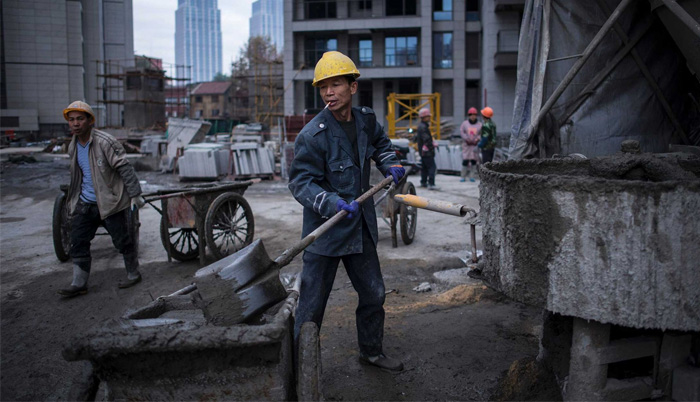![]() Home > World Business
Home > World Business
China Fault Lines: Where Economic Turbulence Could Erupt in 2017

Photographer: Johannes Eisele/AFP via Getty Images
![]() December 29th, 2016 | 09:14 AM |
December 29th, 2016 | 09:14 AM | ![]() 761 views
761 views
CHINA
China’s balancing act isn’t getting any easier.
Policy makers are grappling with how to attack excessive borrowing and rein in soaring property prices while maintaining rapid growth. They’re also battling yuan depreciation and capital outflow pressures as U.S. interest rates rise, while on the horizon looms the risk of confrontation with America’s President-elect Donald Trump on trade and Taiwan.
It’s a high-wire act with the potential to produce shocks, like the one erupting in the bond market as tighter liquidity threatens financing for small companies. President Xi Jinping told top officials he’s open to growth below the 6.5 percent target to 2020 if it carries too much risk, a person familiar with the situation said last week. Leaders have pledged to reduce hazards for 2017.
While forecasters have been raising growth estimates for next year and don’t expect major turbulence, the following are among areas they flag as having the potential to trigger a plunge in growth or systemic risk in the financial system:
Quickening Outflows
Outflows will exceed $200 billion in the fourth quarter and rise further in the first quarter, said Pauline Loong, managing director at research firm Asia-Analytica in Hong Kong.
Capital is leaving for more fundamental reasons than rising U.S. rates and a stronger dollar, she said. Drivers include rising expectations of yuan weakness, fears of an abrupt policy U-turn trapping funds in the country, and a lack of profitable investment opportunities at home amid rising costs and slowing growth.
“The real nightmare for Beijing – and for markets – is a vicious cycle of capital outflows triggering bigger devaluations of the yuan that in turn drive bigger and faster outflows,” Loong said. “We expect capital outflows to increase in the coming months as Chinese money seeks to maximize exit quotas in case of more stringent restrictions later on."
Trade War
Trump’s appointment of Peter Navarro, a frequent critic of China’s trade practices, to a newly formed White House National Trade Council, increases the risk of turbulence between the world’s two biggest economies. An editorial Friday in the state-run China Daily accused him of "anti-China alarmism" and said appointing the "Death by China" author is another sign Trump seems intent on confrontation.
Saber rattling by the countries could unsettle markets next year with the risk that each side finds it politically attractive to play to their populist base, said David Loevinger, a former China specialist at the U.S. Treasury.
“Amping up the blame game is the foreign policy equivalent of eating candy for dinner,” said Loevinger, now an analyst at fund manager TCW Group Inc. in Los Angeles. “There’s a short-term rush, but it leads to problems down the line. Using each other as scapegoats actually makes it harder for the U.S. and China to cut deals on trade and security issues.”
Policy Error
Policy-execution error is a major hazard next year, said Geoffrey Yu, head of the U.K. investment office at UBS Wealth Management in London. With monetary conditions already tightening “quite aggressively,” he sees over-tightening as among the biggest risks. “To offset such risks, a big fiscal boost is needed,” Yu said.
A major surprise next year will be how monetary tightening exposes China’s financial risks because of the buildup of debt in recent years, said Shen Jianguang, chief Asia economist at Mizuho Securities Asia Ltd. in Hong Kong.
Property Slump
Growth will slow as a property downturn sees construction and related investment further decelerate, and that could be exacerbated by infrastructure investment shortfalls due to a scarcity of attractive investment projects, according to Wang Tao, head of China economic research at UBS Group AG in Hong Kong. She projects growth will slow to 6.4 percent next year from 6.7 percent in this year, in line with economist estimates in a Bloomberg survey.
China International Capital Corp., which has raised its growth forecast for next year to 6.7 percent from 6.6 percent, said one of the main risks to that outcome was harsher-than-expected property tightening.
Base Case
Even if fault lines hold, growth is on pace for the slowest annual expansion since 1990. To prevent a steeper drop, policy makers must remain nimble in navigating multiple threats.
China is unlikely to carry out bold reforms next year in advance of the twice-a-decade Communist Party congress – at which as many as five out of seven members of the nation’s top leadership committee are expected to be replaced – said David Dollar, a senior fellow at the Brookings Institution in Washington and former U.S. Treasury attache to Beijing.
“There’s more downside risk than upside risk for China and the world in 2017,” Dollar said. “Hence risks will continue to build up and hopefully duct tape will keep it all together."
Source:
courtesy of BLOOMBERG
by Bloomberg News
If you have any stories or news that you would like to share with the global online community, please feel free to share it with us by contacting us directly at [email protected]